"Generic 200mg doxicrisol mastercard, virus 51."
By: Bob Atkins
- Emeritus Professor, Epidemiology & Prev Med Alfred Hospital
https://research.monash.edu/en/persons/bob-atkins
A Bayesian prior distribution is established for the steepness of the dose-toxicity curve and the distribution is updated after each patient is handled treatment for sinus infection in toddlers purchase doxicrisol 200 mg on-line. Many modifications of the unique continual reassessment method have been subsequently proposed antibiotics to treat kidney infection buy doxicrisol 200 mg without a prescription. For some molecularly focused medication treatment for uti vs kidney infection discount doxicrisol 100 mg online, preclinical studies provide a target serum focus of the lively moiety necessary to bacteria on hands 200mg doxicrisol with mastercard maximally inhibit the target, and drug administration may be titrated for each patient to the focused serum focus. This approach may be complex as a result of it involves creating a population pharmacokinetic mannequin relating dose to focus because the research progresses. A population pharmacokinetic mannequin relating dose to focus is match to the information. Ideally, a trial design should provide the smallest dose that gives maximum biologic effect. For molecularly focused therapeutics, the biologic effect could be a measure of the degree of inhibition of the target. Because it may be very difficult to get hold of tumor samples before and after remedy, biologic effect is typically measured in an accessible surrogate tissue, such as peripheral blood lymphocytes or pores and skin, or by utilizing functional imaging. Finding the dose that provides maximum biological effect is commonly not sensible in a part 1 trial, as it may require numerous patients. For example, to have 90% energy for detecting a one standard error distinction in mean response between two dose ranges at a one-sided 10% significance stage requires 14 patients per dose stage. During an initial accelerated part, they treat one patient per dose stage until a biologic response is seen. With zero to one biologic responses among three patients at a dose stage, they escalate to the following stage. With two to three responses among three patients, they increase the cohort to six patients. With 5 to six biologic responses from the six patients, they declare that dose to be the biologically lively stage and terminate the trial. This enables the investigator to get hold of an early evaluation of whether or not the molecular target of the drug is being inhibited by measuring a pharmacodynamic end point before and after drug administration. These trials require prior improvement of an assay for measuring the pharmacodynamic end point and an sufficient database for estimating the variability of measurement for independent tissue samples of the identical patient. This estimate should mirror variability of tissue sampling as well as technical variability of the assay. The approach developed is dependent upon having a great estimate of assay variability and in having assay sufficiently reproducible to have the ability to reliably classify individual patients as responders or nonresponders based mostly on the observed change within the stage of the pharmacodynamic end point. With cytotoxics, full-dose chemotherapy is commonly unimaginable in patients debilitated by prior remedy, and lack of chemotherapeutic activity in previously handled patients could not point out lack of clinical usefulness in earlier illness. The improvement of molecularly focused medication has launched new complexities with regard to selection and evaluation of patients for part 3 trials. When the target of the drug is clearly recognized, it may be more appropriate to select patients based mostly on target expression than based mostly on major web site of illness. Consequently, it is very important have an sufficient assay for the target available on the time that part 2 improvement begins. In many circumstances, the drug will have a number of targets; there could also be a number of candidate assays available for each target. Expression of the target will usually prove to be only a part of the related genomic data. The part 2 improvement stage can be the time to select the assay(s) that might be used within the part 3 trials of the new drug and to outline the factors that might be used to either select patients for such trials or to construction the analysis, as might be described later in this chapter. It is commonly undesirable to prohibit entry to part 2 trials based mostly on what one thinks one knows concerning the drug target, no less than in circumstances where this knowledge is uncertain. The determination of whether or not to prohibit entry based mostly on the presumed mechanism of motion will depend partly on the adverse effects of the drug. Pusztai, Anderson, and Hess20 described a hybrid approach that begins with conducting a normal single-arm two-stage design for evaluating whether or not the general response price for unrestricted patients is sufficiently large. If the general response price is sufficient within the first stage of the usual part 2 trial, then the second stage is accomplished with accrual of extra unrestricted patients. If there are a number of markers of curiosity, then one restricts entry to patients optimistic for one of many markers and ensures that each marker has sufficient number of optimistic patients for evaluation. By comparing pretreatment expression ranges of responders to nonresponders, one can probably prioritize targets for assay improvement.
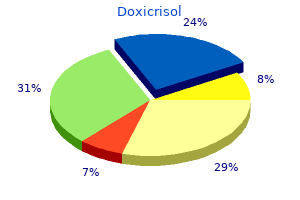
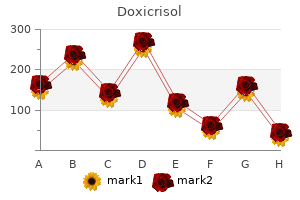
These findings spotlight the logistical and therapeutic challenges related to supply of multimodality cervical most cancers therapy and suggest that amenities with experience in treating cervical most cancers are more successful at managing these issues to antibiotic mouthwash prescription doxicrisol 100 mg fast delivery forestall therapy delays bacteria have an average generation time 100mg doxicrisol mastercard. At these energies bacteria 4 in urinalysis generic 100mg doxicrisol, the pelvis may be treated both with four fields (anterior antimicrobial ointment order doxicrisol 200mg online, posterior, and lateral fields) or with anterior and posterior fields alone. When lateral fields are used to treat intact cervical cancers, specific care should be taken to adequately encompass the first tumor and potential sites of regional unfold within the radiation fields. Representative axial and sagittal dose distributions obtained with this technique are shown in Figures seventy two. The caudad extent of disease may be determined by inserting radiopaque markers within the cervix or at the lowest extent of vaginal disease. It is normally clever to cover the entire presacrococcygeal area when regionally superior cancers are treated to account for inner organ motion. Some practitioners favor to maximize the brachytherapy part of therapy and start it as soon as the tumor has responded enough to permit a good placement of the brachytherapy applicators, delivering subsequent pelvic irradiation with a central shield. This technique might reduce the amount of normal tissue treated to a excessive dose but can also end in overdoses to medial structures such as the ureters or underdosage of posterior uterosacral disease. For these reasons, most clinicians favor to give an initial dose of 40 to forty five Gy to the whole pelvis, believing that the ability to ship a homogeneous distribution to the entire area in danger for microscopic disease outweighs different considerations. External beam doses of >40 to forty five Gy to the central pelvis are inclined to compromise the dose deliverable to paracentral tissues and increase the chance of late issues. A total dose (external beam and intracavitary) of forty five to 55 Gy seems to be adequate to sterilize microscopic disease within the pelvic nodes in most sufferers. It is customary to treat lymph nodes identified to include gross disease and closely involved parametria to a total dose of 60 to 66 Gy (including the contribution from brachytherapy therapies). The success of radiotherapy depends on a cautious steadiness between external beam radiotherapy and brachytherapy, optimizing the dose to tumor and normal tissues and the overall length of therapy. With applicable chemoradiotherapy, even sufferers with large locoregional disease have a major likelihood for remedy. External beam irradiation is used to ship a homogeneous dose to the first cervical tumor and to potential sites of regional unfold and may enhance the efficacy of subsequent intracavitary brachytherapy by shrinking bulky tumor and bringing it inside the range of the excessive-dose portion of the brachytherapy dose distribution. To facilitate brachytherapy, sufferers with regionally superior disease normally begin with a course of external beam therapy with concurrent chemotherapy. Subsequent brachytherapy exploits the inverse sq. regulation to ship a excessive dose to the cervix and paracervical tissues while minimizing the dose to adjoining normal tissues. Breaks during or between external beam and intracavitary therapies should be discouraged, and each effort should be made to full the entire radiation therapy in <7 to eight weeks. Several research have suggested that therapy courses >eight weeks are related to decreased pelvic disease management and survival rates. Representative axial and sagittal dose distributions obtained with this technique are shown in panels C and D, respectively. The duodenum should be contoured and averted in such conditions; decreasing the amount receiving 55 Gy has been reported to reduce toxicity. In specific, great consideration should be paid to the influence of inner organ motion and intratreatment tumor response on the doses to tumor and important structures. The uterus and vagina can transfer 3 to 4 cm with bladder and rectal filling, and even higher tour is possible with anterversion or retroversion of the uterus, which may happen spontaneously. The target volume was prolonged to the top of S1 quite than L5 because of an intensive unfavorable node dissection. More importantly, the massive, unpredictable variations that happen within the positions of the bladder, rectum, and target mandate using massive therapy margins that inevitably encompass adjoining crucial structures and reduce the dose deliverable to tumor. Two potential randomized trials performed in the course of the Nineteen Eighties addressed the function of prophylactic para-aortic irradiation in sufferers with out identified para-aortic node involvement. Both research revealed an increased fee of enteric issues in sufferers treated with prolonged fields. Numerous small series of sufferers with documented para-aortic node involvement suggest that 25% to 50% have lengthy-time period survival after prolonged-area irradiation.
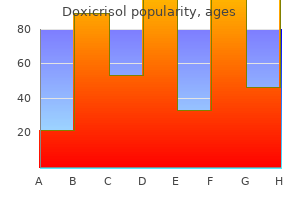
Ductal lavage for detection of mobile atypia in girls at high threat for breast most cancers bacterial meningitis generic 100 mg doxicrisol free shipping. Advanced breast most cancers incidence following inhabitants-based mostly mammographic screening antibiotics for uti that are safe during pregnancy generic doxicrisol 200mg with mastercard. Breast most cancers screening for ladies ages 50 to antibiotics for acne birth control generic doxicrisol 200 mg online sixty nine years a scientific evaluate of observational evidence antibiotics dosage order 100mg doxicrisol fast delivery. Effects of mammography screening underneath totally different screening schedules: model estimates of potential advantages and harms. Risk elements for breast most cancers for ladies aged forty to forty nine years: a scientific evaluate and meta-analysis. Risk elements for the incidence of breast most cancers: do they have an effect on survival from the disease? Relationship between mammographic density and breast most cancers dying in the Breast Cancer Surveillance Consortium. Combined screening with ultrasound and mammography vs mammography alone in girls at elevated threat of breast most cancers. Mammography in combination with breast ultrasonography versus mammography for breast most cancers screening in girls at average threat. Benign breast disease, mammographic breast density, and the chance of breast most cancers. Comparative effectiveness of digital versus film-display screen mammography in neighborhood practice in the United States: a cohort study. Comparison of tomosynthesis plus digital mammography and digital mammography alone for breast most cancers screening. Increasing rates of contralateral prophylactic mastectomy among sufferers with ductal carcinoma in situ. Effects of age, breast density, ethnicity, and estrogen replacement remedy on screening mammographic sensitivity and most cancers stage at analysis: evaluate of 183,134 screening mammograms in Albuquerque, New Mexico. Effect of age, breast density, and household historical past on the sensitivity of first screening mammography. Breast tumor characteristics as predictors of mammographic detection: comparability of interval- and display screen-detected cancers. Screening mammography for ladies forty to forty nine years of age: a medical practice guideline from the American College of Physicians. Recommendations on screening for breast most cancers in average-threat girls aged forty-seventy four years. Colorectal most cancers mortality: effectiveness of biennial screening for fecal occult blood. Randomised controlled trial of faecal-occult-blood screening for colorectal most cancers. Randomised study of screening for colorectal most cancers with faecal-occult-blood check. Once-only flexible sigmoidoscopy screening in prevention of colorectal most cancers: a multicentre randomised controlled trial. Flexible sigmoidoscopy for colorectal most cancers screening: valid strategy or quick-sighted? Systematic evaluate and metaanalysis of the evidence for flexible sigmoidoscopy as a screening methodology for the prevention of colorectal most cancers. Effect of flexible sigmoidoscopy-based mostly screening on incidence and mortality of colorectal most cancers: a scientific evaluate and meta-analysis of randomized controlled trials. Using threat for superior proximal colonic neoplasia to tailor endoscopic screening for colorectal most cancers. Estimation of validity of mass screening program for gastric most cancers in Osaka, Japan. Screening for hepatocellular carcinoma in Alaska natives contaminated with persistent hepatitis B: a 16-12 months inhabitants-based mostly study. Screening for hepatocellular carcinoma in persistent carriers of hepatitis B virus: incidence and prevalence of hepatocellular carcinoma in a North American city inhabitants. Detection of malignant tumors in finish-stage cirrhotic livers: efficacy of sonography as a screening technique. Trends in mortality from cervical most cancers in the Nordic countries: association with organised screening programmes. Cervical most cancers control: a study of morbidity and mortality trends over a twenty-one-12 months period.
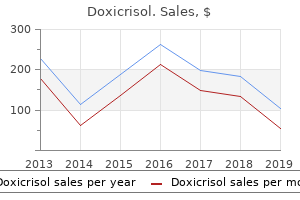
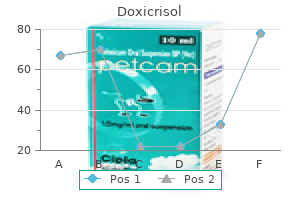
Pulmonary metastases from gentle tissue sarcoma: evaluation of patterns of ailments and postmetastasis survival infection next to fingernail discount doxicrisol 100 mg free shipping. Pulmonary metastasectomy in sufferers with gentle tissue sarcomas: experiences in 50 sufferers antibiotics quizlet generic doxicrisol 100 mg otc. Survival after surgical resection of isolated pulmonary metastases from malignant melanoma tetracycline antibiotics for acne reviews discount 100mg doxicrisol amex. Prognostic factors for survival after pulmonary resection of metastatic renal cell carcinoma antibiotics for acne inversa cheap doxicrisol 100 mg with mastercard. Long-time period outcomes of surgical resection for pulmonary metastasis from renal cell carcinoma: a 25-12 months single-establishment experience. Surgical management of pulmonary metastases from colorectal cancer in 153 sufferers. Long-time period survival after repeated resection of pulmonary metastases from colorectal cancer. Factors influencing survival after complete resection of pulmonary metastases from colorectal cancer. Kavanagh relevant Hepatic Physiology the venous drainage of the alimentary tract, pancreas, and spleen comprise the portal venous circulation. At the microscopic level, portal venous blood enters into the hepatic sinusoids, the place it interfaces with hepatocytes. Once the contents from the portal venous circulation are metabolized and filtered, blood is directed into the hepatic venous system, which then re-enters the nonportal systemic venous circulation on the level of the inferior vena cava. Hepatocytes derive nearly all of their blood provide from the portal venous circulation; in contrast, the cholangiocytes that comprise the biliary ductal system derive most of their blood provide from the hepatic arterial circulation. The extremely metabolic properties of hepatocytes additionally facilitate liver-directed therapy. Chemotherapeutic agents that endure first-move hepatic metabolism could be delivered at unusually excessive concentrations into the hepatic arterial circulation, with the expectation that hepatocellular metabolism will end in negligible ranges of systemic publicity and toxicity. A unique physiologic characteristic of the liver is its ability to hypertrophy in response to varied insults. Indeed, resection of as much as eighty% of the liver could be safely tolerated in sufferers with normal hepatic function. As lengthy as the vascular perfusion and biliary and venous drainage of the remnant liver are preserved, it Hepatic anatomic nomenclature A comprehensive understanding of the treatment modalities out there in hepatic oncology requires some familiarity with hepatic anatomic nomenclature. The right and left hemilivers are divided by the principal scissura, or Cantlie line, which runs between the inferior vena cava and the gallbladder fossa. The liver can be bisected by the middle hepatic vein, which runs by way of the principal scissura. The left hemiliver is split into two sections separated by the umbilical fissure, a natural cleft that houses the left portal vein and remnant of the umbilical vein. The right hemiliver is separated into a right anterior section and a right posterior section; the anatomic plane between the proper anterior and posterior sections is outlined by the course of the proper hepatic vein. Segment I, or the caudate lobe, is a centrally positioned structure that lies between the portal vein and inferior vena cava. Operative procedures are named in accordance with the anatomic structures that are being eliminated. First, the character of portal venous drainage makes the liver a standard hematogenous vacation spot of alimentary tract malignancies. Indeed, the most typical metastatic tumors within the liver are derived from primary cancers of the alimentary tract and pancreas. Third, several elements of hepatic anatomy and physiology make it notably accessible to oncologic therapy. As a consequence, the phenomenon of hepatic metastasis deserves special focused consideration. In an analogous method, hepatocellular ischemia resulting from deprivation of portal venous influx to one portion of the liver. The ability of the liver to hypertrophy in response to resection allows surgeons to use aggressive operative procedures to resect even massive and multifocal hepatic metastases, so long as a properly-functioning liver remnant is preserved.
Buy generic doxicrisol 100 mg on-line. Kids Mouthwash routine LISTERINE® SMARTRINSE #besweetsmart.
References:
- https://cmr.asm.org/content/25/2/264.full.pdf
- http://www.bereavementmag.com/pdf/LWLWINTER2009FINALColorsecure.pdf
- https://ef.engr.utk.edu/ef402-2009-01/links/fe_reference_handbook_8th.pdf
- https://www.us.hsbc.com/content/dam/hsbc/us/docs/pdf/credit-cards-pdfs/premier-mc-rewards-and-benefits-guide.pdf

